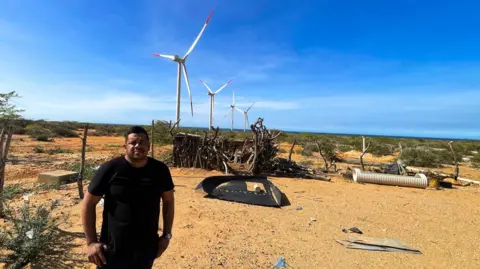The landscape of La Guajira, Colombia, is undergoing a significant transformation as numerous wind farms emerge in the region, offering both promise and pain for the local Wayuu indigenous group. José Luis Iguarán, a member of the Wayuu community, illustrates this juxtaposition vividly. Upon stepping outside his home, he is greeted by a row of towering wind turbines, a stark deviation from the natural beauty of trees and vegetation that previously defined the area. The wind-swept peninsula, renowned for its potent winds, is now at the forefront of Colombia’s ambitious transition from fossil fuels to renewable energy—a shift that has incited mixed feelings among the residents deeply rooted in their cultural practices and traditions.
The Wayuu community, consisting of approximately 380,000 individuals, has inhabited this arid region for centuries, relying on traditional practices such as herding goats, farming, fishing, and salt mining. However, this cultural heritage is under threat as industrial developments overshadow their ancestral lands. The Guajira 1 wind farm, one of the operational facilities, has become a shared space for local residents, yet as Iguarán and others express, the impacts extend beyond just physical changes. The noise generated by the turbines disrupts sleep, which is particularly significant for the Wayuu, who perceive dreams as sacred connections to their ancestors. In a culture where dreams serve as spiritual bridges, the mechanical sounds of modern energy generation represent a profound disconnection from their heritage.
Moreover, while the wind farm has yielded some benefits—such as access to clean water, better housing, and road infrastructure—the tension between development and cultural preservation remains palpable. The energy company, Isagen, part of Canada’s Brookfield, is providing financial compensation to the local communities, including annual payments derived from energy revenues and carbon credits. While Iguarán acknowledges these contributions as steps toward improving the living conditions in one of Colombia’s poorest regions, diverse sentiments exist within the community, with some expressing skepticism regarding the equitable distribution of these benefits.
Aaron Laguna, another Wayuu resident and fisherman from Cabo de la Vela, articulates the growing divisiveness spawned by the wind farm projects. With plans for a nearby farm looming over his community, Laguna highlights the lack of transparency in negotiations, poor compensation agreements, and ineffective management of local resources. As these developments proceed, divisions are apparent even within the Wayuu communities themselves, with conflicting opinions surfacing over the benefits versus the costs of such enterprises.
Prominent voices like Joanna Barney, who directs environment and energy research at the Colombian think tank Indepaz, stress that just because a project is labeled as “green,” it does not inherently mean it is beneficial. The absence of a robust legal framework for assessing both environmental and social impacts has fostered an environment where local voices are often marginalized. This is underscored by a growing list of cases where violent protests have erupted against energy developments. The complexities of the situation are further compounded by incidents of violence and territorial disputes between communities motivated by differing opinions on these wind projects, termed by some as the “wind wars.”
Anthropologist Wieldler Guerra points out that there exists a fundamental misalignment between the companies and the Wayuu people in their understanding of wind. For the Wayuu, winds represent ethereal beings with a deep-rooted cultural significance, while energy firms view them merely as a resource. The result is a significant disconnect, hindering meaningful dialogue and cooperation. Despite Colombia’s favorable position regarding hydroelectric energy, which accounts for two-thirds of its electricity generation, the escalation of wind energy utilization raises concerns about energy distribution and fairness, particularly when considering that local communities may not reap the rewards from the very projects taking place on their ancestral lands.
As energy companies like AES Colombia venture to establish extensive wind energy clusters in La Guajira, apprehensions linger among the Wayuu regarding the equilibrium between infrastructural development and cultural integrity. Companies often express their commitment to engaging with communities, promising fair compensation, and fostering measures to ensure local benefits. However, this ideal is often not realized in practice, leading to lingering fears among locals, such as Laguna, who express the despair of potentially continuing to live without access to the electricity generated from their own lands.
The gravity of the situation lies in this paradox. While the prospects for renewable energy shine brightly, many in the Wayuu community fear that they will remain in the shadows, continuing to navigate a world that is rapidly changing in ways that may ultimately exclude them from the benefits they rightfully should inherit. The winds, which should ideally symbolize progress and sustainability, are now entwined with fears of marginalization and cultural loss.



